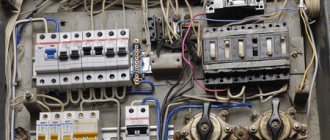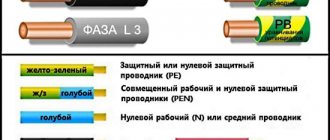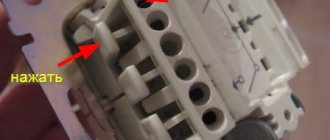Wire colors and designations
In order to find the phase, neutral and ground wires of electrical wiring without instruments, they, in accordance with the rules of the Electrical Installation Code, are covered with insulation of different colors.
The photo shows the color marking of the electrical cable for single-phase electrical wiring with an alternating current voltage of 220 V.
This photo shows the color coding of an electrical cable for 380V AC three-phase wiring.
According to the presented diagrams, wires began to be marked in Russia in 2011. In the USSR, the color marking was different, which must be taken into account when searching for phase and zero when connecting installation electrical products to old electrical wiring.
Wire color coding table before and after 2011
| Period of validity of the PUE | First phaseL1 | Second phase L2 | Third phase L3 | Neutral wire, N | Ground wire, PE |
| Until January 1, 2011 | yellow | green | red | blue | yellow - green (black) |
| After January 1, 2011 | brown | black | grey | light blue | yellow - green |
The table shows the color marking of electrical wiring wires adopted in the USSR and Russia. In some other countries the color markings are different, with the exception of yellow-green
wires. There is no international standard yet.
The designations L1, L2 and L3 do not indicate the same phase wire. The voltage between these wires is 380 V. Between any of the phase and neutral wires, the voltage is 220 V, and it is supplied to the electrical wiring of the house or apartment.
What is the difference between N and PE wires in electrical wiring
yellow-green ground wire must also be supplied to the apartment
.
The neutral N and grounding PE wires are connected to one grounded bus of the panel in the entrance of the house. But they perform different functions. The neutral wire is intended for electrical wiring, and the grounding wire is intended to protect people from electric shock and is connected to the housings of electrical appliances through the third contact of the electrical plug. If an insulation breakdown occurs and a phase gets into the body of an electrical device, then all the current will flow through the grounding wire, the fuse links will burn out or the circuit breaker will trip, and no person will be harmed.
If the electrical wiring is laid indoors with a cable without color marking, it is impossible to determine where the neutral conductor is and where the grounding conductor is, since the resistance between the wires is hundredths of an ohm. The only clue can be the fact that the neutral wire is inserted into the electric meter, and the grounding wire passes by the meter.
Attention! Touching exposed parts of a circuit connected to an electrical outlet may result in electric shock.
How to find zero and phase
At home, even without special instruments and devices, it is possible to determine in a regular outlet which of the two wires is a phase and which is a zero. In this case, an electric lamp or an indicator screwdriver is used.
Checking with an electric lamp
To find zero and phase, just take an ordinary socket with a light bulb and screw two wires into its regular places. Then connect one of these wires to the grounding blades in the socket, and the second to either of the two power connectors.
The phase connector will be the one to which the light bulb will light up when connected. This happens because, according to the Electrical Installation Rules (PUE), in the input electrical panel, the neutral wires of all sockets must be connected to the ground wires of the same sockets. A separate earth bus must be connected to a protective ground loop. This is what ensures the presence of a reliable zero in the entire energy supply chain of the house.
You may be interested in this Features of the cross section
Electric lamp
Note! It is permissible to carry out such procedures independently only in cases where there is nowhere to wait for qualified help, as well as in the event of an emergency (fire, short circuit, person under voltage). Do not forget that electric current is very dangerous. Don't risk your health and your life over a light bulb!
Indicator screwdriver
In order to determine the phase in an alternating current network with a voltage of 220V - 230V, you can use a household voltage indicator - an indicator screwdriver. It is sold in almost any hardware store and is (depending on the design) very inexpensive.
An example of a working indicator screwdriver
As a rule, such tools do not have instructions for use, so in order to avoid electrical injury, you should remember a few simple rules that apply to any tool that comes into contact with live parts:
- Use the tool only for its intended purpose (it is prohibited to use the voltage indicator - indicator screwdriver - as an ordinary screwdriver for tightening/unscrewing screws, self-tapping screws, screws, etc.)
- Before using the tool, you should carefully consider the condition of the insulation on the handle and tip (applicable to any screwdrivers, including indicator ones). Do not use the device under any circumstances if the insulating coating is chipped or missing altogether.
- It is necessary to check the functionality of indicator devices on electrical installations that are known to be energized (for example, in an extension cord into which a working electrical appliance is connected).
Screwdriver with insulated blade
If there is any doubt about the functionality of the indicator, it should be considered faulty and the electrical installation functional.
There are also more accurate and safer instruments for determining the presence of voltage in the network - these are multimeters, current clamps, volt-ampere phase meters (VAF) and others.
Multimeter
In everyday life, as a rule, simple multimeters are used. They are able to show the presence of voltage in the network and its value. It is much safer to use these devices to determine the phase, since their probes have a dielectric handle. The principle of determination is the same as in the case of a cartridge - it is enough to apply one probe to the ground contact of the socket, and place the second one on one of the two contacts of the socket.
Multimeter example
Important! Like traffic rules, electrical safety rules must be followed, because electric current is invisible, inaudible and intangible, and this is precisely why it is dangerous.
You may be interested in How to check phase and zero
Electricity (according to Newton's second law) does not appear from nowhere and does not go to nowhere. It is produced, transported and consumed before our eyes. We need to know where it comes from, how it gets to us and in what form. Everyone should understand that in household use there are wires that can harm human health, and there are also those that are completely harmless, so a little knowledge and a minimum of instruments are needed to identify and distinguish between these wires. But it is better to trust any manipulations with electricity to a professional - a qualified specialist, in order to avoid disaster.
Phase and zero: concepts and differences
There is such a thing as tension. This word means the degree of electric field strength at a given point or circuit. Otherwise it is called potential. In very simple words, this is a kind of piston that gives an impetus to electrons so that they pass through the wires and light a light bulb in a chandelier.
In the common circuit (phase zero), the one that comes to the chandelier or socket, there are two wires. One of them is a phase. It is this wire that is live. A phase in electrical engineering is comparable to a positive in a car - it is the main power supply for the network.
Zero is a wire that is not energized (this is exactly what distinguishes zero from phase). It is not overloaded during the power take-off process, but, nevertheless, electric current also flows through it, only in the direction opposite to the phase one. In the absence of voltage, it is safe in terms of electric shock to a person.
No necessary equipment
The household should at least have a voltage tester, but if you don’t have one, don’t worry, there are ways to determine ground, zero and phase without instruments.
All you need to do is make a test lamp, approximately the same as shown in the photo. The lamp should operate on 220V and not be too powerful (so as not to blind your eyes).
Warning lamp
There are many options for implementing this device, the main thing is to ensure reliable insulation in the places where the wires and probes are attached to the lamp. Naturally, if you need to test the wires in a box on the ceiling, you need to make probes of the appropriate length.
To determine the phase, it is enough to connect one contact of such a probe to the wire under test, and the second to ground. The latter can be metal heating or cold water pipes. The place on the pipe that you will touch with the test lamp probe must first be cleaned.
The wire, when touched, the lamp will glow, will be the phase.
Why is zeroing necessary?
Humanity actively uses electricity; phase and zero are the most important concepts that need to be known and distinguished. As we have already found out, in phase electricity is supplied to the consumer, zero removes the current in the opposite direction. It is necessary to distinguish between neutral working (N) and neutral protective (PE) conductors. The first is necessary to equalize the phase voltage, the second is used for protective grounding.
Depending on the type of power line, an insulated, solidly grounded or effectively grounded zero can be used. Most power lines supplying the residential sector have a solidly grounded neutral. With a symmetrical load on the phase conductors, the working zero has no voltage. If the load is uneven, the unbalance current flows at zero, and the power supply circuit is able to self-regulate its phases.
Electrical networks with an isolated neutral do not have a neutral working conductor. They use a neutral ground wire. In TN electrical systems, the working and protective neutral conductors are combined throughout the entire circuit and are marked PEN. Combining the working and protective zero is possible only up to the switchgear. From it to the end consumer there are already two zeros - PE and N. The combination of neutral conductors is prohibited for safety reasons, since in the event of a short circuit the phase will be closed to neutral, and all electrical appliances will be under phase voltage.
Types of damage
On the entrance riser
To begin with, let’s take a general look at what the electrical network of a city multi-storey building is.
The power source in this case is a transformer substation, from which wires are stretched to the main distribution board of the building. The voltage in the main panel is three-phase, that is, the network is 380 Volts. From here, groups of wires are already output to each apartment. In the apartments themselves, the network is already single-phase - 220 V. If there is a break in the common zero on the entrance riser, this can cause household appliances to fail. This leads to inequality - in a three-phase power supply circuit there will be a phase imbalance and instead of a symmetrical load, an asymmetrical one is formed, passing in a four-wire circuit. In simple words, this can be explained this way: from the main panel at the entrance to each individual apartment, the same voltage is supplied - 220 V. If the neutral wire breaks, it may turn out that 300 Volts are supplied to one apartment, and 170 to another (as an example). The result – overvoltage and “undervoltage” will cause electrical appliances to fail. Usually, if damage occurs to the zero, equipment with an engine breaks down: washing machine, refrigerator, air conditioner, etc. In addition, a fire may occur, which is even worse.
What is phase imbalance?
Inside the living space
A completely opposite situation can occur if there is a zero break in a single-phase 220 Volt network, that is, inside your apartment, private house or in the country. In this case, the consequence may be electric shock to a person. This happens because in the socket you will have the same phase on both terminals. Now we will tell you what causes the appearance of the so-called second phase.
From your input panel, the current flows through the phase wire, and since most electricity consumers are constantly connected to the network (the same chandelier), if there is a break, the voltage will go from phase to zero. The result is that there will be an electric current in two openings of the socket. But this is not the worst thing, because... The main danger is that electric shock can occur from any equipment. The reason for this is the incorrect grounding system of the network in the apartment or house. If you connect the “ground” in the distribution panel to the zero bus (which you cannot do), when you touch the grounded body of the household appliance, you will immediately get an electric shock. The consequences, as you understand, can be disastrous. We immediately bring to your attention the correct option for protection against zero loss in the house - a network with a TN-S grounding system:
To sum up the consequences of a zero break in a three-phase and single-phase network, the following should be noted: if the neutral wire on the entrance riser is damaged, the danger will spread to household appliances, and if the working zero in the apartment itself is damaged, the threat will spread to you.
You can see what can happen if the zero wire breaks in this video:
At-a-glance overview of the fault










